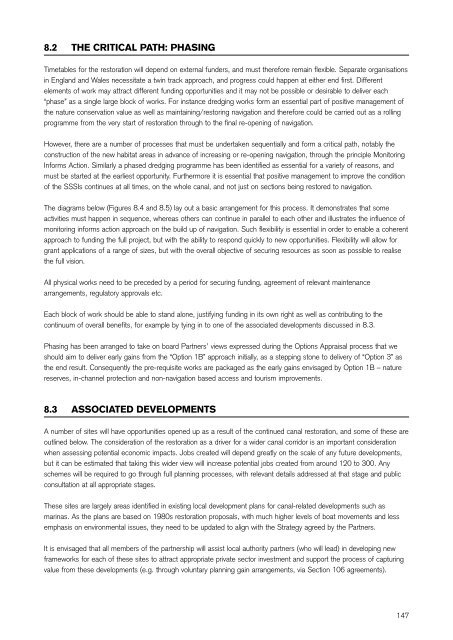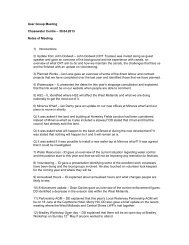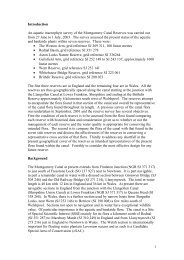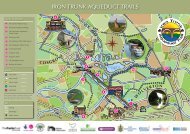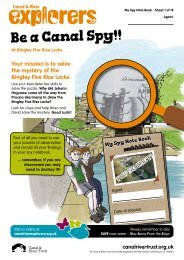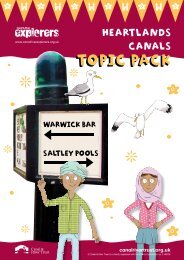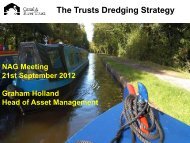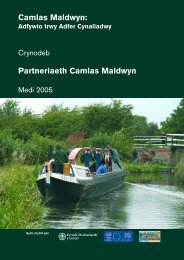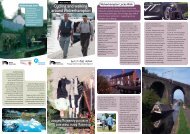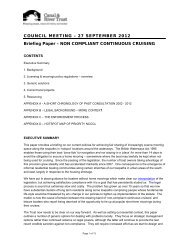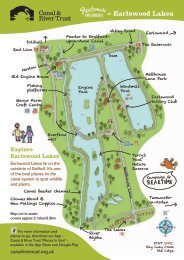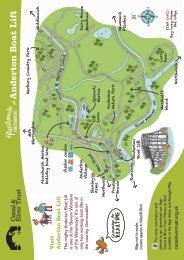Montgomery Canal Conservation Management Strategy (1.2MB PDF)
Montgomery Canal Conservation Management Strategy (1.2MB PDF)
Montgomery Canal Conservation Management Strategy (1.2MB PDF)
Create successful ePaper yourself
Turn your PDF publications into a flip-book with our unique Google optimized e-Paper software.
8.2 THE CRITICAL PATH: PHASING<br />
Timetables for the restoration will depend on external funders, and must therefore remain flexible. Separate organisations<br />
in England and Wales necessitate a twin track approach, and progress could happen at either end first. Different<br />
elements of work may attract different funding opportunities and it may not be possible or desirable to deliver each<br />
“phase” as a single large block of works. For instance dredging works form an essential part of positive management of<br />
the nature conservation value as well as maintaining/restoring navigation and therefore could be carried out as a rolling<br />
programme from the very start of restoration through to the final re-opening of navigation.<br />
However, there are a number of processes that must be undertaken sequentially and form a critical path, notably the<br />
construction of the new habitat areas in advance of increasing or re-opening navigation, through the principle Monitoring<br />
Informs Action. Similarly a phased dredging programme has been identified as essential for a variety of reasons, and<br />
must be started at the earliest opportunity. Furthermore it is essential that positive management to improve the condition<br />
of the SSSIs continues at all times, on the whole canal, and not just on sections being restored to navigation.<br />
The diagrams below (Figures 8.4 and 8.5) lay out a basic arrangement for this process. It demonstrates that some<br />
activities must happen in sequence, whereas others can continue in parallel to each other and illustrates the influence of<br />
monitoring informs action approach on the build up of navigation. Such flexibility is essential in order to enable a coherent<br />
approach to funding the full project, but with the ability to respond quickly to new opportunities. Flexibility will allow for<br />
grant applications of a range of sizes, but with the overall objective of securing resources as soon as possible to realise<br />
the full vision.<br />
All physical works need to be preceded by a period for securing funding, agreement of relevant maintenance<br />
arrangements, regulatory approvals etc.<br />
Each block of work should be able to stand alone, justifying funding in its own right as well as contributing to the<br />
continuum of overall benefits, for example by tying in to one of the associated developments discussed in 8.3.<br />
Phasing has been arranged to take on board Partners’ views expressed during the Options Appraisal process that we<br />
should aim to deliver early gains from the “Option 1B” approach initially, as a stepping stone to delivery of “Option 3” as<br />
the end result. Consequently the pre-requisite works are packaged as the early gains envisaged by Option 1B – nature<br />
reserves, in-channel protection and non-navigation based access and tourism improvements.<br />
8.3 ASSOCIATED DEVELOPMENTS<br />
A number of sites will have opportunities opened up as a result of the continued canal restoration, and some of these are<br />
outlined below. The consideration of the restoration as a driver for a wider canal corridor is an important consideration<br />
when assessing potential economic impacts. Jobs created will depend greatly on the scale of any future developments,<br />
but it can be estimated that taking this wider view will increase potential jobs created from around 120 to 300. Any<br />
schemes will be required to go through full planning processes, with relevant details addressed at that stage and public<br />
consultation at all appropriate stages.<br />
These sites are largely areas identified in existing local development plans for canal-related developments such as<br />
marinas. As the plans are based on 1980s restoration proposals, with much higher levels of boat movements and less<br />
emphasis on environmental issues, they need to be updated to align with the <strong>Strategy</strong> agreed by the Partners.<br />
It is envisaged that all members of the partnership will assist local authority partners (who will lead) in developing new<br />
frameworks for each of these sites to attract appropriate private sector investment and support the process of capturing<br />
value from these developments (e.g. through voluntary planning gain arrangements, via Section 106 agreements).<br />
147


